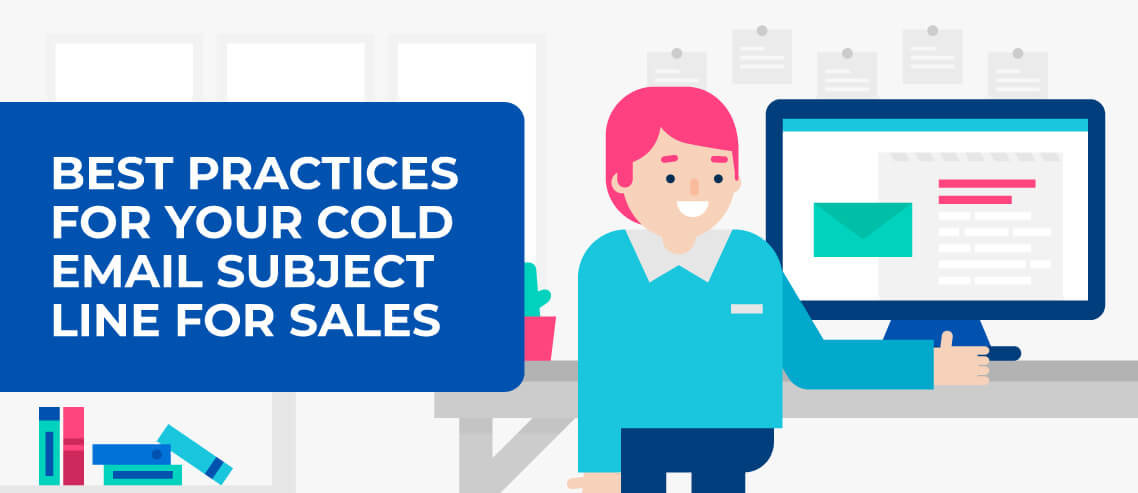How Venngage Uses Cold Email for Content Promotion

Contents
Building and sharing epic content on social media was once a reliable way to earn exposure for your brand and drum up publicity. But today’s content promotion landscape is saturated – in 2016, 89% of marketers said that email is their primary channel for lead generation – and it now requires methodical and relentless outreach to get your content seen and shared.
That’s good news and bad news for businesses looking to kickstart their own content promotion. While there are no shortcuts to content promotion, it also means your hard work and efforts will take the lead over those who wander and lose interest. And fortunately, the statistics on cold email and email marketing are still showing impressive results.
I wrote an article for Forbes earlier this year on the topic of ROI and email marketing, and in it, I shared eye-opening results from a report by the Direct Marketing Association: email marketing yields an average ROI of 4,300%. So if you’re chasing link shares and content promotion exclusively on social media, you’re missing out.
So what does a successful cold email content promotion campaign even look like? And where do you start?
Not enough businesses share their cold email and content promotion strategies, but it’s incredibly helpful to see real-life examples at work. That’s why I recently reached out to Nadya Khoja, director of marketing at Venngage (and a Mailshake customer), to get a look at the cold email outreach techniques that are driving their success.
Here’s how the infographic creation company is building links, social shares and business relationships to promote their content – one cold email at a time.
Using Buzzsumo to Track Down Reporter’s Emails
Venngage’s cold email outreach process starts with identifying highly relevant articles and tracking down the people who wrote them by their Twitter handle or email address.
Venngage relies on Buzzsumo to help pull relevant info together, and looks for articles with a high level of traction and plenty of social shares:
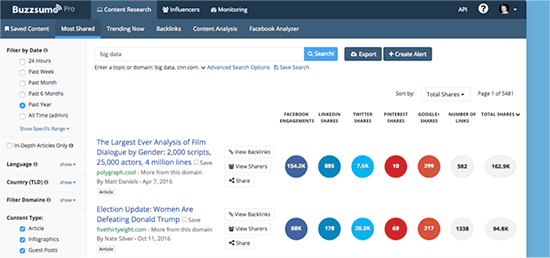
Nadya explains that Venngage uses a virtual assistant to help put all of the emails and relevant information together in a list. However, they also know the importance of getting the actual email right the first time – that’s why they cross-reference the completed email list using a tool like Rapportive to make sure it’s correct:

Image: Rapportive
Nadya emphasizes the importance of researching your recipients and keeping your pitches relevant. “It’s important to do your research,” she says. “Just because someone included the term ‘infographic’ in an article they wrote doesn’t necessarily mean they want to include your infographic in an article.”
Nadya also avoids using reporters’ personal email addresses. She feels pitching business to a personal address is the equivalent of spamming, and dilutes Venngage’s efforts.
Getting as Specific as Possible to Improve Response Rates
Venngage’s techniques are pretty successful for content promotion. Nadya estimates that they see an 80% open rate and roughly a 20% response rate from their cold email outreach. Venngage also improved their cold email campaign results – as mentioned above – by getting as specific as possible with the pitch and using a highly targeted list of reporters writing on that topic. After fine-tuning their process, Venngage saw a 10% follow-through rate on reporters using their infographics.
But it doesn’t end there. Just because 90% of the prospects on their outreach list may not use their infographics in an upcoming article, Venngage still sees reporters sharing their content on social networks. Nadya attributes that social sharing success to building relationships through cold emails and sticking to highly targeted correspondence that offers value:
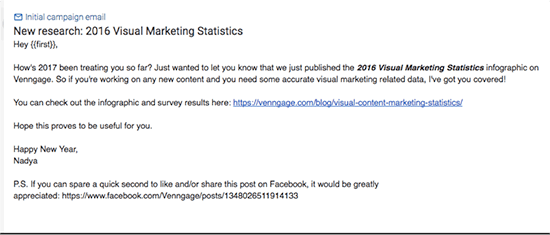
Avoiding Spammy Pitches
Nadya believes that it’s crucial to avoid sounding spammy and wasting people’s time. Steer clear of sending emails that offer product sales that can “help your business,” and instead focus on relationship building from the start with a personable approach.
She also advises marketers to really think about what they respond to in their own inboxes. What subject headings and pitches pique your interest? Chances are high that those emails are written by thoughtful people who value your time and engage with you like a human being. “I definitely recommend showing people you’re interested in talking to them and meeting them – and getting to know them as a person – more than just trying to get something out of them,” Nadya says.
Lloyed Lobo, co-founder of Traction Conference, shared a similar sentiment on HubSpot. “In general, I send casual personable emails like I would email a friend,” he says. “People do business with people, yet many of us tend to be mechanical when sending those initial emails.”
In addition to making sure Venngage’s contacts are highly relevant and receptive to cold emails in the first place with the BuzzSumo technique, Nadya always lets reporters know they can click ‘reply’ and opt out of her list. This also helps reduce the perception of spamming. Ultimately, Nadya makes it easy to say yes – or no – during her email outreach campaign.
Leveraging Email Tools to Speed Up the Cold Outreach Process
In the beginning, Venngage did all of their cold outreach manually, but it didn’t scale very well. Speed matters: the faster you can send out cold emails to a list of content promotion leads, the sooner you can start building up links and shares.
Now Venngage relies on tools like Mailshake to help speed up the process and stay organized – all while keeping their emails sounding authentic. This tactic keeps the flow of cold email outreach steady with the ability to quickly follow up or make notes on who is interested and who isn’t:

Following Up for Success
Venngage’s real cold email success doesn’t necessarily happen during the first or second attempt. The company really sees their strongest results in the follow up, and that follow up is a key contributor to securing content promotion.
But Venngage’s tactic is really about eliciting any kind of response – even if it doesn’t result in successful content promotion placement. As Nadya says, “As long as we can get that initial reply, that’s the most important, so we can gauge how to reply back and find ways to work together that are mutually beneficial to Venngage and the reporter we’re working with.”
Nadya also leaves her follow-ups a little open-ended to prompt reporters to ask for more information and keep the conversation going:
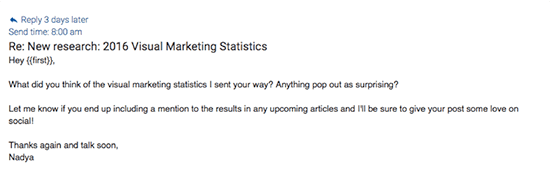
It’s easy to get frustrated when you’re getting no responses to any of your outreach attempts, but in reality, you could crush your competition just by following up. Consider that it takes an average of five cold call attempts to close a sale, yet 70% of salespeople give up after they don’t get a reply to the very first email. Be in that 30% that follows up, and you’re almost guaranteed to increase your success rate.
But that doesn’t mean bombarding someone with emails. Avoid talking about yourself or asking how they can help you – keep your follow up all about the recipient, and pack those emails with value.
Using Cold Email as a Relationship-Building Tool
At the end of the day, cold email is ultimately a relationship-building tool that should be used on an ongoing basis. “It’s definitely a stepping stone to developing relationships,” Nadya says.” I don’t really see cold email as being just a one-time deal.”
And she’s not the only one who thinks so. Dmitry Dragilev of Criminally Prolific successfully used cold email to get his startup acquired, launch a six-figure consulting business, and become friends with Tim Ferriss and the Winklevoss twins. “Don’t be a sales guy,” Dragilev writes on his blog. “Be human. Show that you care about the people you email. Tell them about your shared passions and interests. Remember that your objective is to build relationships, not just close deals.”
There are also other ways to employ cold email that go beyond asking someone to share a piece of content or a link. Nadya also uses cold email as a vehicle to warm people up and ask them to meet for coffee. She’s also used it to land quick phone calls with influencers she wants to build relationships with and eventually get a “yes” from. She knows influencers are bombarded with email pitches and requests all day, so her emails asking them to meet in person or chat by phone stand out in their inbox.
Venngage’s hard work in building relationships to get their content promoted has paid off. Take a look at some of their latest stats on one of Nadya’s recent blog posts, 10 Visual Content Marketing Statistics to Know for 2017:
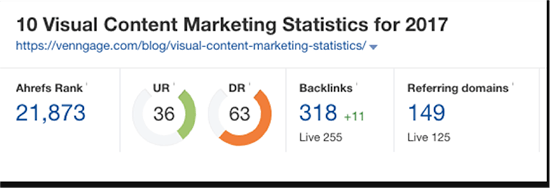
Conclusion
Venngage knows that success in using cold email for content promotion isn’t a short game. They approach every email with a relationship-building mindset. And ultimately, that mindset and methodical process is a more sustainable approach to content promotion than spamming everyone you come across, or posting over and over again on social media.
There is plenty Venngage does right in their cold email outreach, like curating highly relevant lists of reporters and influencers from the start. I will also add that anyone who’s using cold email for content promotion should also avoid these common mistakes:
- Steer clear of generic subject lines, and instead try something compelling that captures attention. That’s how Adam Lyons of The Zebra got Mark Cuban engaged through cold email, and ultimately landed an investment.
- Avoid sending long emails, and show people you really value their time.
- Don’t send out the same pitches that influencers and decision-makers are likely getting all day long. Offer them something truly unique.
- Never make your cold emails all about yourself. The more you think about what the recipient needs – and how you can help – the better your odds of success.
Cold email may take time to scale and show results, but it’s still a successful way to get the “yes” you’re looking for. Integrate the techniques Nadya shared with me, and see how they impact your own cold email outreach for content promotion.
Image: Pexels



